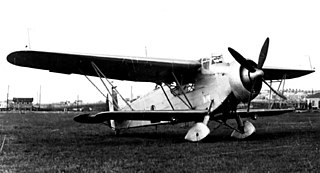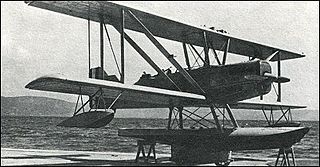Related Research Articles

The Hawker Hedgehog was a three-seat reconnaissance biplane, to be used for naval scouting, produced to meet Air Ministry Specification 37/22.

The Fiat CR.1 was an Italian biplane fighter aircraft of the 1920s. Of wood-and-fabric construction, it was designed by Celestino Rosatelli, from whom it gained the 'CR' designation. Its most distinctive feature was that the lower wings were longer than the upper ones.

The Savoia-Marchetti SM.78 was an Italian bomber/reconnaissance biplane flying boat of the early 1930s.

The Caproni Ca.161 was an aircraft built in Italy in 1936, in an attempt to set a new world altitude record. It was a conventional biplane with two-bay, staggered wings of equal span, based on Caproni's Ca.113 design. The pressure-suited pilot was accommodated in an open cockpit.

The IMAM Ro.30 was a 1930s Italian observation biplane designed and built by Industrie Meccaniche e Aeronautiche Meridionali. It was only built in limited numbers before being replaced by the Ro.37.
The Farman F.51 was a 1920s French maritime reconnaissance flying boat designed and built by Farman. The F.51 was an unequal-span four-bay biplane flying boat with a crew of four. It was powered by two Lorraine 8bd engines mounted in tractor configuration. A pusher engined version was designated the Farman F.50 . Tested by the French Navy but it failed to win any orders, Farman did briefly consider a civil version but the project was abandoned.

The Piaggio P.6 was an Italian catapult-launched reconnaissance floatplane designed and built by Piaggio for the Regia Marina.

The Royal Aircraft Factory R.E.7 was a British two-seat light bomber and reconnaissance biplane designed by the Royal Aircraft Factory and built under contracts by the Coventry Ordnance Works, Austin, Napier and Siddeley-Deasy for the Royal Flying Corps.
The Sopwith Admiralty Type 807 was a 1910s British biplane seaplane designed and built for the Admiralty by the Sopwith Aviation Company.

The Heinkel HE 5, produced in Sweden as the Svenska S 5 and nicknamed the "Hansa", was a reconnaissance floatplane built during the 1920s. It was a further development of the HE 1, sharing its same basic configuration as a low-wing, strut-braced monoplane. The HE designation also refers to the monoplane construction, standing for Heinkel Eindecker.

The Short Type 827 was a 1910s British two-seat reconnaissance floatplane. It was also known as the Short Admiralty Type 827.

The Lübeck-Travemünde F.2 was a 1910s German reconnaissance floatplane. The F.2 was an improved version of the company's earlier F.1 floatplane and was the first armed aircraft built by Flugzeugwerft Lübeck-Travemünde GmbH, a subsidiary of Deutsche Flugzeug-Werke. The F.2 was a twin-float biplane powered by a 220 hp (164 kW) Mercedes D.IV engine. With a crew of two, the observer's rear cockpit was fitted with a 7.92 mm (0.31 in) Parabellum machine gun. Eleven aircraft were built.

The Gloster Goring was a single-engined two-seat biplane designed to meet 1926 Air Ministry specifications for a day/torpedo bomber. It was not put into production and the one aircraft built served later as an engine testbed.

The Westland Weasel was a prototype British two-seat fighter/reconnaissance aircraft of the First World War. Designed to replace the Bristol Fighter, the Weasel was a single engined tractor biplane. Four prototypes were built, but no production followed owing to the failure of its original engine, although the prototypes were used as engine test beds for the successful Armstrong Siddeley Jaguar and Bristol Jupiter engines.

The Fairey Ferret was a 1930s British general-purpose biplane designed and built by the Fairey Aviation Company. It performed well in trials but was not ordered into production.
The Farman B.2 was a 1920s French biplane designed as a light day bomber. Only one was built.

The Douglas XT3D was an American three-seat torpedo bomber biplane developed by the Douglas Aircraft Company to meet a United States Navy requirement.

The Aichi E8A was a prototype Japanese reconnaissance floatplane of the 1930s. It was a two-seat single engined biplane built for the Imperial Japanese Navy. Only two were built.
The Macchi M.40 was a prototype 1920s Italian catapult-launched reconnaissance floatplane designed and built by Macchi, it did not enter production.
The IMAM Ro.26, sometimes called the Romeo Ro.26, was a single-engine biplane trainer aircraft produced by the Italian aeronautical company IMAM in the early 1930s. Only one example was built.
References
Notes
Bibliography
- The Illustrated Encyclopedia of Aircraft (Part Work 1982-1985). Orbis Publishing.